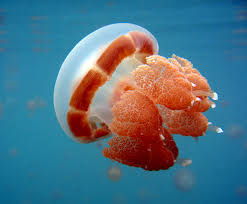Tete-Beche: Sea Wasp Tête-bêche Pair Type I (Romania 2017)
Sea Wasp Tête-bêche Pair Type I (Romania 2017)
07 December (Romania ) within release The most poisonous animals goes into circulation Tete-Beche Sea Wasp Tête-bêche Pair Type I face value 2*4.50 Romanian leu
| Tete-Beche Sea Wasp Tête-bêche Pair Type I in catalogues | |
|---|---|
| Michel: | Mi: RO 7310KDI |
Tete-Beche is vertical format.
Type I tête-bêche pair has one stamp from the top row and one stamp from the inverted second row of the 4x7 sheet. Type II tête-bêche pair has one stamp from the inverted second row and one stamp from the third row of the 4x7 sheet.Also in the issue The most poisonous animals:
- Mini Sheet - Sea wasp (Chironex fleckeri) face value 5*4.50;
- Mini Sheet - Inland taipan (Oxyuranus microlepidotus) face value 5*16;
- Mini Sheet - Southern blue-ringed octopus (Hapalochlaena maculosa) face value 5*3.50;
- Stamp - Golden poison frog (Phyllobates terribilis) face value 4;
- Stamp - Inland taipan (Oxyuranus microlepidotus) face value 16;
- Stamp - Sea wasp (Chironex fleckeri) face value 4.50;
- Stamp - Southern blue-ringed octopus (Hapalochlaena maculosa) face value 3.50;
- Mini Sheet - Golden poison frog (Phyllobates terribilis) face value 5*4;
- Tete-Beche - Golden Poison Frog Tête-bêche Pair Type I face value 2*4;
- Tete-Beche - Golden Poison Frog Tête-bêche Pair Type II face value 2*4;
- Tete-Beche - Southern Blue-ringed Octopus Tête-bêche Pair Type II face value 2*3.50;
- Tete-Beche - Sea Wasp Tête-bêche Pair Type II face value 2*4.50;
- Tete-Beche - Inland Taipan Tête-bêche Pair Type II face value 2*16;
- Tete-Beche - Sea Wasp Tête-bêche Pair Type I face value 2*4.50;
- Tete-Beche - Inland Taipan Tête-bêche Pair Type I face value 2*16;
- Tete-Beche - Southern Blue-ringed Octopus Tête-bêche Pair Type I face value 2*3.50;
Tete-Beche Sea Wasp Tête-bêche Pair Type I it reflects the thematic directions:
Animals are multicellular, eukaryotic organisms of the kingdom Animalia (also called Metazoa). All animals are motile, meaning they can move spontaneously and independently, at some point in their lives. Their body plan eventually becomes fixed as they develop, although some undergo a process of metamorphosis later on in their lives. All animals are heterotrophs: they must ingest other organisms or their products for sustenance.
Jellyfish are animals of the phylum Cnidaria. They are a monophyletic clade, the Medusozoa.Most of them live in the oceans, in salt water, where they eat small sea animals like plankton and little fish, and float in the sea. Only a few jellyfish live in fresh water. They have soft bodies and long, stinging, venomous tentacles that they use to catch their prey, usually small plankton animals or small crustaceans or tiny fish. Some jellyfish hunt others by stinging cells called nematocysts. A jellyfish is 97% waterA map is a symbolic depiction emphasizing relationships between elements of some space, such as objects, regions, or themes. Many maps are static, fixed to paper or some other durable medium, while others are dynamic or interactive. Although most commonly used to depict geography, maps may represent any space, real or imagined, without regard to context or scale, such as in brain mapping, DNA mapping, or computer network topology mapping. The space being mapped may be two dimensional, such as the surface of the earth, three dimensional, such as the interior of the earth, or even more abstract spaces of any dimension, such as arise in modeling phenomena having many independent variables. Although the earliest maps known are of the heavens, geographic maps of territory have a very long tradition and exist from ancient times. The word "map" comes from the medieval Latin Mappa mundi, wherein mappa meant napkin or cloth and mundi the world. Thus, "map" became the shortened term referring to a two-dimensional representation of the surface of the world.
Marine life, or sea life or ocean life, refers to the plants, animals and other organisms that live in the salt water of the sea or ocean, or the brackish water of coastal estuaries. At a fundamental level, marine life helps determine the very nature of our planet. Marine organisms produce much of the oxygen we breathe. Shorelines are in part shaped and protected by marine life, and some marine organisms even help create new land. Altogether there are 230,000 documented marine species, including over 16,000 species of fish, and it has been estimated that nearly two million marine species are yet to be documented. Marine species range in size from the microscopic, including plankton and phytoplankton which can be as small as 0.02 micrometres, to huge cetaceans (whales, dolphins and porpoises) which in the case of the blue whale reach up to 33 metres (109 feet) in length, being the largest known animal.




